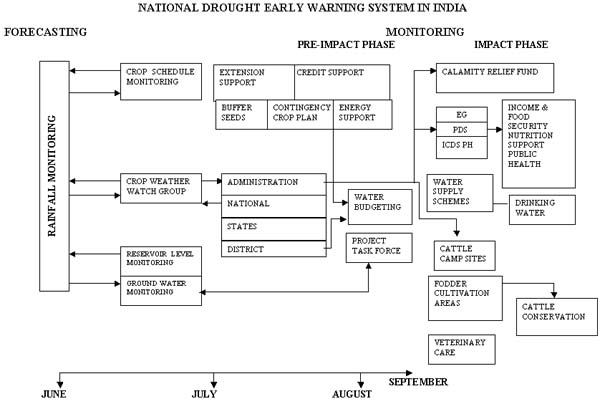|
|
 |
Drought Early Warning Systems in India
Drought Impacts and Coping Mechanisms
Recurring drought-induced food insecurity is a serious development issue in arid, semi-arid and dry sub-humid areas of India. Drought is a slow onset natural hazard and offers opportunity and time to mitigate its impact. The transition from meteorological to hydrological and then agricultural drought constitutes its basic consequences. The deterioration of drought conditions over a period of time leads to famine, the ultimate consequence of drought.
The household response pattern to food crisis generally involves a succession of stages along a continuum of “coping” that runs from risk minimization, absorption and risk-taking to survive. Risk minimization and absorption strategies are those through which households preserve their productive assets to recover in another season after the drought. These are reversible strategies. “Risk taking to survive” strategies are those when a household’s position is so desperate that they sacrifice future security for present survival. These are all less reversible strategies, which leave households worse than before.
Identification of Indicators for Early Warning
Various indicators appear broadly, sequentially reflecting the extent and depth of household stresses. Agro-climatic indicators are leading indicators that reflect the initial signs of risk minimization strategies adopted by households. Market socioeconomic indicators are concurrent and denote risk absorption strategies. Late anthropometric indicators reflect survival symptoms.
The objective of designing an early warning system is to keep track of leading indicators to get ample lead-time to intervene at the drought onset phase itself, compared to early warning systems designed to capture concurrent or late indicators. However, most interventions based on late indicators force governments to adopt a crisis management approach to dealing with drought-induced food insecurity stresses. There are many deficiencies in this approach; and in the long-run it does not reduce vulnerability to drought.
Evolving Early Warning Systems in India
Studies of Indian drought management approaches in the last hundred years reveal that India relied too heavily on crisis management approaches before and during the pre-independence era (before 947). However, after the mid-sixties, based on the experience of tackling the 1966 drought-induced food crisis, serious efforts were made to replace ad hoc crisis management relief interventions with an anticipatory drought management approach.
A drought management approach differs from a relief approach with regard to objectives, reliance on early warning indicators and timing of public intervention. Thus the drought management approach aims at ensuring food production, relying on leading agro-climatic indicators, like rainfall, water level in reservoirs and progress of cropping pattern, to detect early signs of a developing drought situation.
A national-level crop weather watch group (drought forecasting) was established in 1979 to monitor the impact of the monsoon on crop conditions and to suggest corrective measures to minimize crop losses. The National Early Warning System has an integrated drought forecasting and monitoring system at present. It is structured to provide operational and retrospective intelligence for constant information update based on feedback on the impact of intervention measures. While a drought relief approach with a monitoring system enabled the government to intervene only in the months of November- December after the kharif harvest (summer crops) was over, the drought management approach with a forecasting system enabled the government to intervene in July-August (within the monsoon season). This early warning system offered a lead-time of five months before the appearance of distress indicators in December-January. This was evident in the management of a severe multi-year drought during 1985-87.
There are two components of the National Early Warning System: drought forecasting and drought monitoring. The drought forecasting function is carried out by the Inter-Ministerial National Crop Weather Watch Group (CWWG), which meets during the monsoon period from June to September. It monitors the impact of the monsoon on agricultural operations and also suggests corrective measures to minimize any possible adverse impact of aberrant monsoon conditions on crop production as per the standing contingency crop plan. In case the CWWG anticipates widespread adverse seasonal conditions, it sends out a report. This triggers the operationalization of an emergency contingency action plan for drought management, which envisages institutional arrangements and operating procedures for the drought monitoring system.

Early Warning System at Work: Drought 2002
The CWWG was able to assess the potential impact of the long dry spell of July-August 2002 and suggested appropriate intervention measures such as contingency crop planning and water conservation to mitigate the impact of the potential drought in July 2002.
A R Subbiah is presently working as a Program Manager, Extreme Climate Events and Climate Forecasting Applications in Bangladesh. He can be contacted at
subbiah@ait.ac.th
|

